Koppen Climate Classification System is by far the most widely used modern climate classification system.
So, Let’s get to know the Koeppen’s scheme of classification of climate. So this person Wladimir Köppen, who was basically a Russian-German climatologist, he classified the climate of the world by finding a close relationship between the vegetation and the climate of a particular region.
His aim was to make a chart with formulas and notations that would define the climatic boundaries in such a way that it showed close similarity with the existing vegetation.
In simple terms, he looked at the trees and plants of a particular region and then he figured out the relationship between the vegetation and the climate of that region. By finding a close relationship between the two, he created a chart which categorized different climates in groups along with its characteristic traits.
He selected certain values of temperature and precipitation and related them to the distribution of vegetation and used these values for classifying the climates.
He classified the entire world climate by assigning alphabetical letters (capital letters) – A, B, C, D, E, and H. These categories are further subdivided into subdivisions and types by indicating small letters like – a, b, c, d, h, f, m, w, k, and s.
But, Before we discuss in detail the Koppen Climate Classification System, Let’s have a look at the differences between weather and climate.
Differences between weather and climate –
| Climate | Weather | |
| Definition | Describes the average conditions expected at a specific place at a given time (considerable time). A region’s climate is generated by the climate system, which has five components: atmosphere, hydrosphere, cryosphere, land surface, and biosphere. | Describes the atmospheric conditions at a specific place at a specific point in time. Weather generally refers to day-to-day temperature and precipitation activity |
|---|---|---|
| Components | Climate may include precipitation, temperature, humidity, sunshine, wind velocity, phenomena such as fog, frost, and hail storms over a long period of time. | Weather includes sunshine, rain, cloud cover, winds, hail, snow, sleet, freezing rain, flooding, blizzards, ice storms, thunderstorms, steady rains from a cold front or warm front, excessive heat, heat waves and more |
| Forecast | By aggregates of weather statistics over periods of 30 years | By collecting meteorological data, like air temperature, pressure, humidity, solar radiation, wind speeds and direction etc. |
| Determining factors | Aggregating weather statistics over periods of 30 years (“climate normals”). | Real-time measurements of atmospheric pressure, temperature, wind speed and direction, humidity, precipitation, cloud cover, and other variables |
| About | Climate is defined as statistical weather information that describes the variation of weather at a given place for a specified interval. | Weather is the day-to-day state of the atmosphere, and its short-term (minutes to weeks) variation |
| Time period | Measured over a long period | Measured for short term |
| Study | Climatology | Meteorology |
Koppen Climate Classification System
Wladimir Köppen (1846– 1940; pronounced like “kur-pin” with a silent r) was a Russian-born German climatologist who was also an amateur botanist.
The first version of his climate classification scheme appeared in 1918, and he continued to modify and refine it for the rest of his life, the last version being published in 1936.
The modified Köppen system describes five major climate groups (groups A, B, C, D, and E) which are subdivided into a total of 14 individual climate types, along with the special category of highland (H) climate.
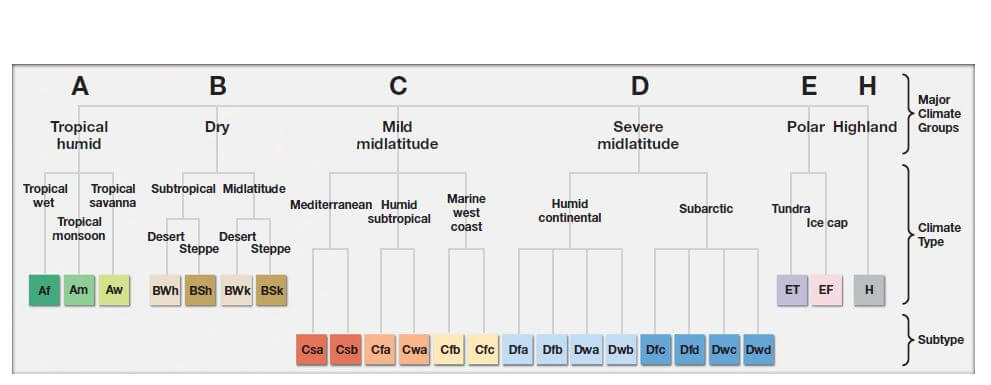
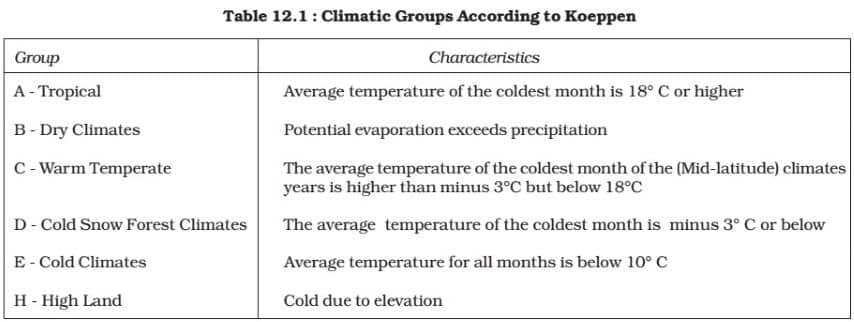
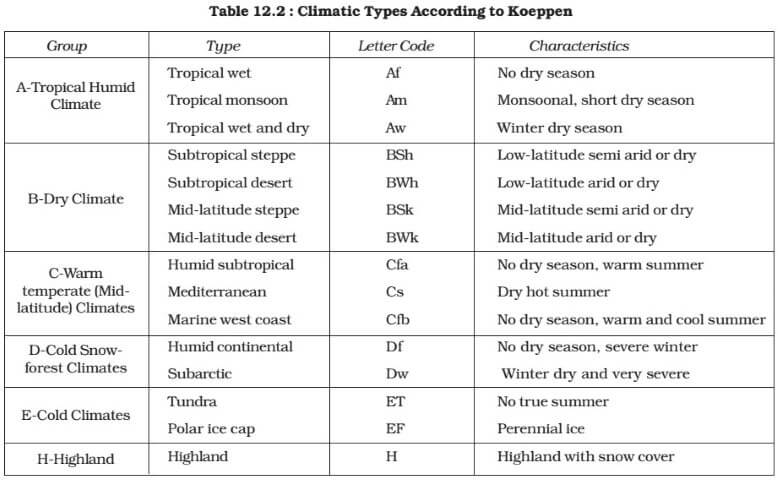
- Koeppen recognized five major climatic groups, four of them are based on temperature and one on precipitation.
- The capital letters:
- A, C, D, and E delineate humid climates and
- B dry climates.
- The climatic groups are subdivided into types, designated by small letters, based on seasonality of precipitation and temperature characteristics.
- The seasons of dryness are indicated by the small letters: f, m, w, and s, where
- f – no dry season,
- m – monsoon climate,
- w – winter dry season and
- s – summer dry season.
- The above mentioned major climatic types are further subdivided depending upon the seasonal distribution of rainfall or degree of dryness or cold.
- a: hot summer, the average temperature of the warmest month over 22°C
- c: cool summer, the average temperature of the warmest month under 22°C
- f: no dry season
- w: the dry season in winter
- s: the dry season in summer
- g: Gange’s type of annual march of temperature; hottest month comes before the solstice and the summer rainy season.
- h: average annual temperature under 18°C
- m (monsoon): short dry season.
- The capital letters S and W are employed to designate the two subdivisions of dry climate:
- semi-arid or Steppe (S) and
- arid or desert (W).
- Capital letters T and F are similarly used to designate the two subdivisions of polar climate
- tundra (T) and
- icecap (F).
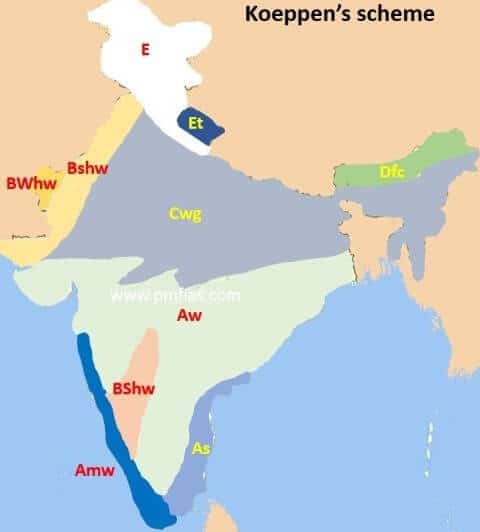
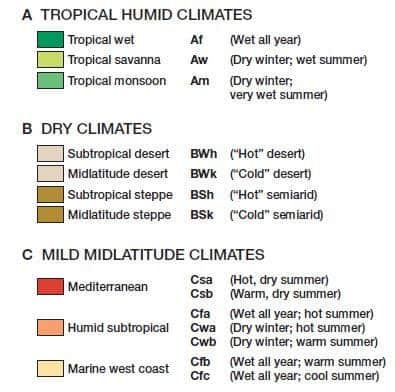
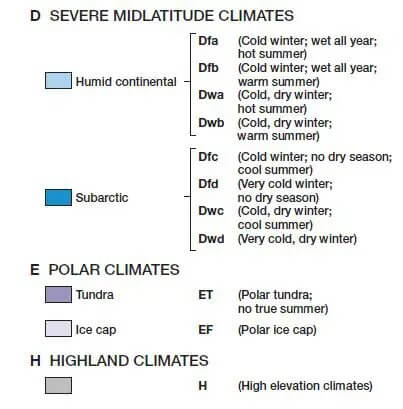
Watch complete playlist (19 videos) –
A – Tropical Moist Climates

Tropical moist climates can be found about 15 to 25 degrees latitude northwards and southwards of the equator. The distinctive feature of this climactic zone is that temperatures in these zones remain above 18 degrees Celcius all throughout the year. Annual precipitation in this climactic zone is usually above 1,500 mm.
Within this broad climatic zone, three minor climactic types also exist, whose classification is based on the seasonal distribution of rainfall in these climatic zones. Areas falling under these climatic zones usually consist of naturally dense tropical forests.
The first is Af, or tropical wet climate, where the climate is tropical with precipitation all year round.
- Monthly variations in temperature in these regions are less than about 3 degrees C.
- The extremely high humidity and surface temperatures in these regions cause cumulus and cumulonimbus clouds to form early into the afternoons every day, resulting in a high amount of precipitation.
The second is a tropical monsoon climate, designated as Am.
- In these regions, the annual precipitation is nearly similar to that of Af, but here most of the precipitation occurs within the 7 to 9 of the warmest months of the year.
- Less rainfall occurs in these regions in the rest of the year.
The third sub-division is Aw, or the tropical wet and dry climate, or the savanna climate.
- These climactic zones experience an extended dry season during the winter season.
- During the wet season, precipitation is usually less than 1,000 mm and occurs mostly during the summer season.
B – Dry Climates

Temperature is not as much of a factor in these climatic zones as precipitation, or rather the lack of it is in these climatic zones. In these climatic zones, evaporation and transpiration exceed the total precipitation. These climactic regions extend 20 to 35 degrees latitude northwards and southwards from the equator and are present in large continental regions in the mid-latitudes or are encircled by mountainous regions.
There are four broad sub-divisions of this climactic zone.
The first is BW, or dry arid climate also called the true desert climate and covers about 12 percent of the Earth’s total land area.
- Areas falling under this climatic zone are habitats for xerophytic vegetation.
- The letters h and k are suffixed after BW to signify whether the dry arid zone is located in the sub-tropics or the mid-latitudes respectively.
The second is BS, or dry semi-arid climate, also referred to as steppe climate.
- This forms a sort of grassland climate that is present on about 14 percent of the Earth’s surface.
- Regions coming under dry semi-arid climate or BS receives more precipitation than the regions under the dry arid climate or BW, which is mainly due to mid-latitude cyclones or due to the inter-tropical convergence zone.
The letters h and k are suffixed in a similar way to BW zones to define the location of the climatic zone in the sub-tropics or in the mid-latitudes respectively.
C – Moist Sub-tropical Mid-latitude Climates

In this climactic zone, summers are usually warm and humid while winters are mild. These climactic zones extend 30 to 50 degrees latitude northwards and southwards from the equator and are present mainly at the eastern and western extremes of most continents.
Summer months feature many convective thunderstorms and winter months feature some mid-latitude cyclones. Three subdivisions exist for this form of the climactic zone.
The first is the humid subtropical climate or Cfa, where summers are hot and humid with frequent thunderstorms.
- The winters are comparatively mild and precipitation during this period occurs due to mid-latitude cyclones, like in the southeastern USA for example.
The second is the Cfb marine climates that are usually found on the western coasts of continents.
- The climate here is largely humid with a hot and dry summer.
- Winters are mild, although accompanied by heavy precipitation due to mid-latitude cyclones.
The third is the Mediterranean climatic zone or Cs, where rainfall mostly occurs during the mild winters due to the mid-latitude cyclones.
- Precipitation during the summer months in this climactic zone can be extremely scanty. Areas falling under this climatic zone can include locations in Portland, Oregon, and California for example.
D – Moist Continental Mid-latitude Climates

In moist continental mid-latitude climates, summers are warm and can also be cool while winters are cold. The regions with moist continental mid-latitude climates are usually located polewards from the moist sub-tropical mid-latitude climates or C climates. Average temperatures in the warmest months are usually more than 10 degrees C, while temperatures in the coldest months can be less than minus 3 degrees C.
Winters in these regions can be bitterly cold, with strong winds and snowstorms that flow from the Continental Polar and the Arctic air masses.
There are three sub-divisions in this form of Koppen climate classification, namely, Dw – with dry winters, Ds – with dry summers, and Df – with precipitation all year round.
E – Polar Climates

In Polar climates, temperatures are low all year round with the warmest month having temperatures less than 10 degrees C. Polar climates occur in the northern coastal areas of Asia, Europe, and North America and on Greenland and Antarctica. Polar climates have two sub-divisions.
The first is ET or Polar Tundra in which soil occurs as permanently frozen as permafrost extending hundreds of meters in depth. Most vegetation found here occurs in the form of dwarf trees, woody shrubs, lichens, and mosses.
The second is EF or Polar Ice Caps, which have a surface that is permanently covered with ice or snow.
Pros of Koppen Classification
- Quantitative: easier to understand and measure
- Co-incides with vegetation pattern
- Gave importance to effective precipitation (evapotranspiration)
Cons of Koppen Classification
- Too much emphasis on average values
- Koppen based his classification of the mean monthly values of temperature and precipitation. By these statistics, the most potent factor of precipitation can only be estimated, rather than measured accurately. This makes comparison from one locality to another rather difficult.
- Ignored precipitation intensity, cloud cover, daily temperature variations, number of rainy days, etc.
- Koppen did not take into account such weather elements as winds, precipitation intensity, amount of cloudiness, and daily temperature extremes for the sake of making his classification generalized and simple.
- Ignored the role of Air masses
- It is empirical and, therefore, is based on facts and observations. The causative factors of climate have been totally ignored. Thus, the air masses, which form the very basis of modern climatology, could not find any place in Koppen’s classification
- Was not a genetic classification

I teach a biogeography course and always go through the Koeppen and Holdridge classification systems. I like the explanations of the Koeppen climate types and the figures and tables. Very nice. I was hoping to see (maybe I missed it?) the variables t and r and the equations used to infer a climate type. I do have the equations, but was interested to see your explanations and usage. Nonetheless, a great site.
Thanks Brian
Since a long time I’m looking for an upsc geography notes on other platforms but now I found geography notes for upsc here and now I would start my preparation..
Sir/ma’am I just want to know when will the remaining lecture be uploaded of climatology…
Soon
How long will it take to upload the remaining lecture?please upload as soon as possible because this is the only platform from where I’m preparing my geography for my upcoming examinations..
And Thank you soo much for your this hard efforts for notes.
wonderful explaination
Indian map is inaccurate.
Thanx so much for these mind-blowing notes
great content.. but please use a proper Indian map..